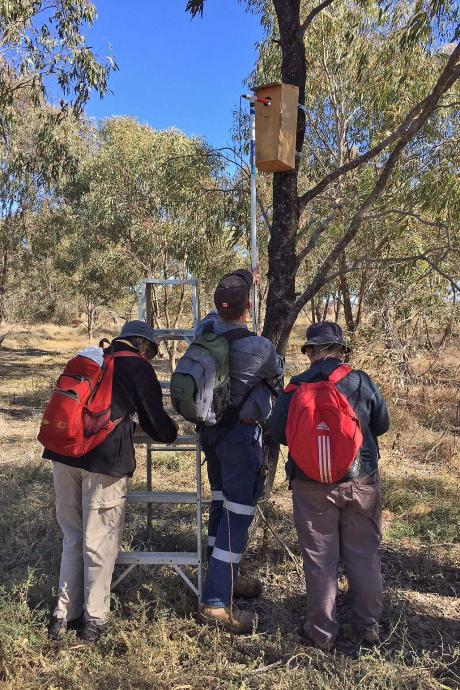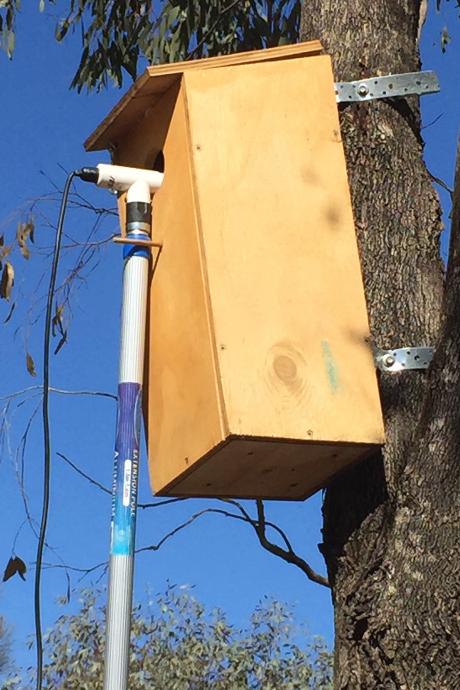NESTBOX INSPECTION AT FIVEBOUGH


Murrumbidgee Field Naturalists were asked if we would be interested in doing some monitoring of the recently installed nestboxes at Fivebough Wetlands. They were made and installed last year by the Work for the Dole crew who have done such fantastic work down there.
We were definitely interested in putting our newly acquired nest box inspection camera to use and agreed to have a look and see what we could find. We assembled on a Tuesday morning, 4 September equipped with GPS’s, a ladder and camera.
The task involved wandering through the young woodlands, finding the nestboxes, numbering them with tags then logging their GPS co-ordinates. We found 34 boxes and that there were two styles of boxes used.
One was of a common vertical design which was ideal for our camera. We could put it in the entrance hole and have a good look at what was in there. The second style was a more horizontal design with a piece of PVC pipe for an entrance. These types would be suitable for Pardalotes and probably other species, but not so choice for our kind of camera. The camera is designed to look down rather than out.
Fortunately, all the boxes have hinged lids, aren’t installed too high and we had a ladder with us, so we could still have a look inside these boxes.
Three boxes had feathers in them indicating some birds have obviously been in them. One of these had grass arranged in a circular pattern resembling a nest of some sort. No egg fragments were visible, but these remains are often consumed by the birds. This box was possibly used for nesting. The other two boxes with feathers had some grass in them but not enough to form a nest. Maybe the bird had second thoughts about nesting there?
Arachnids were inhabiting most of the boxes, usually Sparassid species (Huntsman spiders). Spider cocoons and egg sacs were common. A lot of the boxes had unidentified scats. Two boxes had abandoned bee hives. The remains of insects, after being consumed by something were evident in some. We wondered about the plant debris (leaves and gum nuts) in the boxes – was it blown or carried in by something?
This was a very rewarding exercise for the Field Nats. One thing we determined was the value of getting an image of every box and examining it on the computer at home. What isn’t evident on the small LCD screen in the field becomes more obvious on the larger monitor. A seemingly empty box can have very interesting contents.
We will also change our methodology next time to make it easier to match the images with the nest box #. Many thanks to all the Field Nats who helped on the day.
Glenn Currie
Fivebough Wetlands on Show
Fivebough Wetlands has again had the opportunity to showcase its highly valued ecosystems and wildlife to the community, with recent dignitaries paying a visit in August. The Executive Director of Crown Lands attended a field walk, hosted by the Griffith District Office, to experience the reserve first hand and admire the amazing works undertaken over the past four years. It was a great opportunity to share the wetlands with more senior levels of management of the Department and impress with the splendour of the site.
Fivebough has also been on show for its educational significance with over 100 year 7 students from St Francis visiting the site in early September, to learn about the interwoven network of ecosystem processes and the importance of managing the site for ecological values.
Visitors will notice the new footbridge access from Petersham Road carpark, finished recently and hopefully an aesthetic improvement from the former footbridge. The bridge and bollard are designed to restrict motorbike access to the reserve while providing improved access for wheelchair and mobility scooter visitors. There are of course some limiting factors identified with the new bollard in place, requiring a key hire system, which is being discussed further between the Department and the Tourist Information Centre to implement the best use arrangement for wheelchair and mobility scooter users.
Bec Bryne
NSW Department of Industry – Lands & Water
